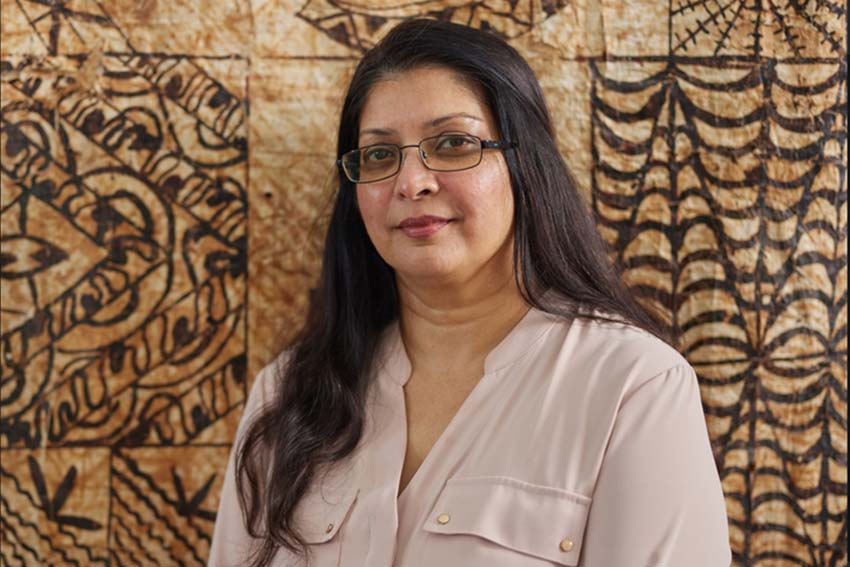Funding for stroke digital tool trial

It’s been another busy year for Dr Rita Krishnamurthi, Professor at the School of Clinical Studies.
Not only was she part of the team - led by Professor Valery Feigin – that claimed the Prime Minister’s Science Prize in May, she has also received a double-dose of good news recently with new funding and professional recognition of her presentation skills.
The latter came during Collaborative Research Symposium 2023, where Professor Krishnamurthi claimed the Auckland Medical Research Foundation Best Senior presentation award, for talking about changes in hospital admission for stroke between 1981 and 2022.
“I just pre-recorded my talk and pressed the submit button,” she laughs. “If I had realised I was up for an award I would have tried to look a bit better.”
Despite the self-deprecation, the subject itself goes to the heart of Professor Krishnamurthi’s expertise, particularly around strokes.
“The number of people going into hospital for stroke is increasing, like it's doubled since 1981,” she says.
“But the number of beds, rehabilitation support and post-discharge care hasn’t doubled in that time. The number of nurses and doctors hasn’t either. Moreover, people with stroke often have co-morbidities, meaning they are high health end-users. If that keeps happening then the healthcare system will break, so we need to stop people having strokes.”
Which leads nicely to her research project that’s just been funded by the Health Research Council of New Zealand to the tune of $1.44 million over the next four years.
The money will be used for a randomised controlled trial using digital technologies to try to prevent strokes and transient ischemic attacks (TIAs), which is becoming increasingly important as more younger people are having them.
“A major gap in stroke prevention is the lack of evidence-based tools to assist clinicians in assessing and providing tailored prevention recommendations to their patients and for patients to receive continued care after discharge from hospital,” says Professor Krishnamurthi.
The project is designed to address that gap by using software called PreventS-MD, a tool for clinicians developed by Professor Feigin and the team at the National Institute for Stroke and Applied Neurosciences (NISAN) for clinicians, in combination with the Stroke Riskometer, a downloadable smartphone app for people in the community.
“The study aims to test whether these two digital tools are effective in improving adherence to doctors' recommendations, hence reducing blood pressure and cholesterol levels,” Professor Krishnamurthi says.
“This funding will allow the gathering of evidence with data from clinicians and stroke patients in real time, in terms of improvements in modifiable risk factors, crucial for stroke prevention.
“The impact of the findings of this trial could be significant. Digital technologies are now being used in almost every area of health but there are no tools specifically tailored for stroke clinicians, patients and whanau.
“If implemented in clinical settings, these tools could lead to substantial decreases in stroke burden, saving many lives and many millions of dollars in healthcare burden.”
The reason the software can have such a big impact it because strokes are “highly preventable”, she says.
“Even if you've had a stroke, a minor stroke or a TIA, that's not the end of the story. You could have another stroke and the next could be quite serious or even fatal.
“Clinicians need a tool which they can use to assess all the various risk factors that a person has and give them recommendations when they leave the hospital.”
This means thinking about more than just the acute stage of recovery in the first few weeks and months, but for an extended time post-discharge.
"If PreventS-MD is implemented in hospital settings, it can be automatically prepopulated with all of the patient’s data, including demographic information and medical information, like their blood pressure and history.
“Then the built-in algorithm allows the software to calculate that person's risk of having another stroke. Or even a heart attack, as the risk factors are very similar for both.”
If that person is a smoker, for example, it will give some guidelines around how it affects their chances of having another stroke as well as guidelines around what to do to reduce or stop smoking.
Patients and doctors are then able to see graphically how changes in lifestyle impacts the risk of another event.
“It gives people a dynamic way of setting goals,” Professor Krishnamurthi says.
The second part of the health intervention is the Stroke Riskometer mobile app, which is again personalised to each patient’s own health records. It’s for use by the patients once they’re out of hospital.
For example, if high blood pressure is a risk factor the app will give you tips for reducing it as well as letting you know your goal for reducing blood pressure
“You can put in reminders about taking your medication or about lifestyle,” Professor Krishnamurthi says.
“Like you need to go for a walk today or cut down on how many cigarettes you smoke. It's personalised, and people can very much tailor it to themselves.
“That's the whole idea of this. It's all about stopping that next big event from happening. Or reducing the risk of it at least,” she concludes.